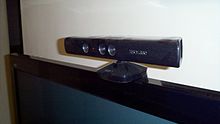- Motion detection
-
Motion detection is a process of confirming a change in position of an object relative to its surroundings or the change in the surroundings relative to an object. This detection can be achieved by both mechanical and electronic methods. In addition to discrete, on or off motion detection, it can also consist of magnitude detection that can measure and quantify the strength or speed of this motion or the object that created it.[1]
When motion detection is accomplished by natural organisms, it is called motion perception.
Motion can be detected by: sound (acoustic sensors), opacity (optical and infrared sensors and video image processors), geomagnetism (magnetic sensors, magnetometers), reflection of transmitted energy (infrared laser radar, ultrasonic sensors, and microwave radar sensors), electromagnetic induction (inductive-loop detectors), and vibration (triboelectric, seismic, and inertia-switch sensors). Acoustic sensors are based on: electret effect, inductive coupling, capacitive coupling, triboelectric effect, piezoelectric effect, and fiber optic transmission. Radar intrusion sensors have the lowest rate of false alarms.
 Microsoft Kinect sensor on a Television.
Microsoft Kinect sensor on a Television.
Contents
Mechanical Detection
The most basic form of mechanical motion detection is in the form of a switch or trigger. These motion detection devices are common in our everyday lives. The keys of a typewriter, or even the keys on the keyboards used to type this article employ a mechanical method of detecting motion. Each key is a manual switch that is either off or on. Each letter that appears is a result of motion on that corresponding key and the switch being turned on. This simple binary code concept is at the heart of the digital age, with mechanical switches being replaced by ever shrinking Transistors.[2][3]
Electronic Detection
See also: Motion estimationThe principal methods by which motion can be electronically identified are optical detection and acoustical detection. Infrared light or laser technology may be used for optical detection. Motion detection devices, such as PIR motion detectors, have a sensor that detects a disterbance in the infrared spectrum, such as a person or an animal. Once detected, an electronic signal can activate an alarm or a camera that can capture an image or video of the motioner.[4] [5]
The chief applications for such detection are (a) detection of unauthorized entry, (b) detection of cessation of occupancy of an area to extinguish lighting and (c) detection of a moving object which triggers a camera to record subsequent events. The motion detector is thus a linchpin of electronic security systems, but is also a valuable tool in preventing the illumination of unoccupied spaces. [6]
A simple algorithm for motion detection by a fixed camera compares the current image with a reference image and simply counts the number of different pixels. Since images will naturally differ due to factors such as varying lighting, camera flicker, and CCD dark currents, pre-processing is useful to reduce the number of false positive alarms.
More complex algorithms are necessary to detect motion when the camera itself is moving, or when the motion of a specific object must be detected in a field containing other movement which can be ignored. An example might be a painting surrounded by visitors in an art gallery.
Occupancy Sensors for Lighting Control
Motion sensors are often used in indoor spaces to control electric lighting. If no motion is detected, it is assumed that the space is empty, and thus does not need to be lit. Turning off the lights in such circumstances can save substantial amounts of energy. In lighting practice occupancy sensors are sometime also called "presence sensors" or "vacancy sensors".
System design and components
Occupancy sensors for lighting control use infrared (IR) or acoustic technology, or a combination of the two. The field of view of the sensor must be carefully selected/adjusted so that it responds only to motion in the space served by the controlled lighting. For example, an occupancy sensor controlling lights in an office should not detect motion in the corridor outside the office. Sensors and their placement are never perfect, therefore most systems incorporate a delay time before switching. This delay time is often user-selectable, but a typical default value is 15 minutes. This means that the sensor must detect no motion for the entire delay time before the lights are switched. Most systems switch lights off at the end of the delay time, but more sophisticated systems with dimming technology reduce lighting slowly to a minimum level (or zero) over several minutes, to minimize the potential disruption in adjacent spaces. If lights are off and an occupant re-enters a space, most current systems switch lights back on when motion is detected. However, systems designed to switch lights off automatically with no occupancy, and that require the occupant to switch lights on when they re-enter are gaining in popularity due to their potential for increased energy savings. These savings accrue because in a spaces with access to daylight the occupant may decide on their return that they no longer require supplemental electric light. [7]
See also
References
External Links
Categories:
Wikimedia Foundation. 2010.
